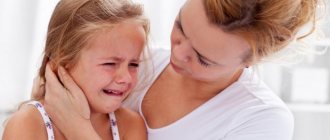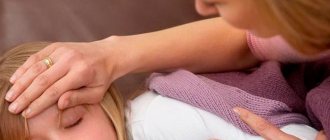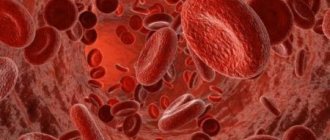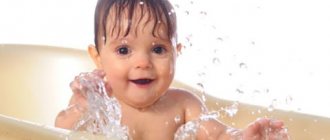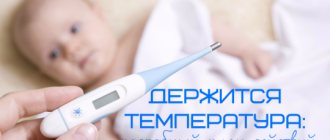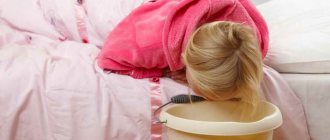You can share the article with friends via social media. networks:
Treatment of a child with antibiotics is prescribed for various diseases; without the use of these drugs, severe complications may develop in some pathologies. Antibacterial therapy must be prescribed by a doctor, indicating the exact dosage, time and frequency of administration. But parents should also know other nuances of antibiotic treatment; in particular, many are interested in the question of when the child can be fed after taking these medications, and whether a special diet is necessary while taking the medications. Before answering this question accurately, you need to understand why antibiotics are needed and what side changes they can cause in children’s bodies.
Indications for prescribing antibiotics to a child
Antibiotics are medications whose main component is a substance that inhibits the growth and reproduction of bacteria. Antibacterial therapy is prescribed for colds and inflammatory diseases of the respiratory tract and internal organs, and for infections of the kidneys and skin. Some drugs from this group have antitumor activity. When it is necessary to take antibiotics, the doctor must decide, since independent choice of drugs can cause a worsening of the underlying disease. When prescribing antibacterial therapy, several rules of administration should be taken into account:
- The use of antibiotics is of no use for a viral infection. Therefore, you should not start giving them for simple rhinitis, sore throat and cough.
- Antibiotics are divided into several groups, each of them has a special mechanism of action and can only have a detrimental effect on certain microflora. The choice of medication is based on the child’s age, the presence of allergic reactions, it is also necessary to take into account the severity of the disease and whether antibacterial therapy has been used previously.
- It is necessary to strictly adhere to the prescribed dosage regimen. This means that the dosage and total duration of treatment should be observed. Self-discontinuation of the drug often ends in the development of complications, the treatment of which may require the use of much more chemically heavy drugs.
- When taking antibiotics, you should adhere to equal intervals. The medicine can be prescribed 2-3 times a day, but it should be drunk at the same time interval, this will create the same concentration of the drug in the blood and means that bacteria will be continuously destroyed.
- The effectiveness of antibacterial treatment is usually assessed within the first two to three days from the start of taking antibiotics. If during this time the symptoms of the developing disease do not decrease, then it is necessary to notify the attending physician, who will select a stronger remedy. Ideally, before prescribing an antibacterial course, a sensitivity culture is done, but such an analysis must wait two to three days; naturally, this is not always advisable.
The use of antibiotics causes adverse reactions in some cases. Nausea, weakness, loose stools - all these unpleasant changes in the body indicate increased sensitivity to drugs, but are not a reason to discontinue the drug. Side effects usually go away on their own when the course of therapy ends.
The least toxic effect of antibiotics on the child’s body is observed if parents adhere to all the rules for prescribing these medications. Therefore, you should definitely know when and what to feed your child during the period of using antibacterial therapy and after treatment. Following a diet can reduce the severity of adverse reactions and greatly increases the effectiveness of medications.
Diet after antibiotics for children
After antibiotic treatment, it is vital to restore the child’s intestinal microflora, metabolism, liver function and immunity.
What happens to the body after treatment with antibiotics?
The digestive system takes the brunt. An antibiotic is a substance that inhibits bacterial growth and kills bacteria. Pediatricians prescribe antibiotics to treat bacterial infections in children. But in addition to the fact that antibiotics kill “bad”, pathogenic bacteria, they also kill “good” ones - those responsible for healthy intestinal microflora. That is, the antibiotic passes through the entire gastrointestinal tract of the child, essentially sterilizing him. And the lack of beneficial bacteria necessarily reduces immunity. Because there is a deficiency of enzymes responsible for digestion. And the vitamins that come from food are not absorbed by the body in the required amount. In addition, a decrease in the number of beneficial bacteria leads to the proliferation of fungi. Stomatitis and candidiasis can develop on the child’s mucous membranes - in the mouth or genitals. Other common consequences of taking antibiotics are dysbacteriosis, tonsillitis, and allergies. Naturally, we don't need this. Therefore, we restore it competently.
What products does a child need?
Probiotics.
Beneficial bacteria necessary for restoring microflora, digestion, immunity, normalizing hormonal levels, and the body’s resistance to infections. Necessary for trading so that vitamins and microelements from food are absorbed in the required volume.
Where are they contained:
homemade cottage cheese, homemade yogurt, kefir (pediatricians recommend eating and drinking fermented milk products in the evening, even before bed - they are better absorbed).
Important! Fermented milk products must be fresh, “alive” - the shelf life should not exceed 7 days.
How to choose the right dairy and fermented milk products How to make homemade cottage cheese How to make homemade yogurt
(In addition to food, you can ask your pediatrician to recommend a pharmacy product with probiotics.)
Fresh vegetables and fruits.
This substrate is the necessary “food” for the growth of beneficial bacteria (probiotics).
Antioxidants.
An antibiotic is a toxic substance that disrupts the functioning of the entire body as a whole. Therefore, antioxidants that can remove free radicals (formed when taking medications for a long time) must be introduced into the child’s diet.
Antioxidant Products:
Avocados, apricots, asparagus, broccoli, berries, carrots, cauliflower, fish, grapefruit, red grapes, oatmeal, mint, pumpkin, spinach, sweet potatoes, green leafy vegetables, melon, tomatoes.
Water.
It is necessary to drink at least 6-8 glasses of clean water a day to quickly cleanse the body and normalize metabolism.
How long should you stick to the diet?
Any recovery course would be good for 3 weeks. Focus on this deadline.
When a child’s body is attacked by an infection, doctors often prescribe treatment with antibiotics. These are drugs that destroy various bacteria. Although the treatment is aimed at pathogenic microorganisms, the beneficial microflora of the child’s intestines also suffers. Antibiotics inhibit not only bad bacteria, but also those that serve the body as protection and are involved in digestion. This leads to dysbiosis. When deprived of beneficial microflora, not only the intestines suffer, but the entire body. After taking antibacterial drugs, the child loses appetite, slowly gains weight, and his immune system weakens. These factors lead to frequent colds and vitamin deficiency. If taking antibiotics has this effect on the body, then how can a child’s body be restored after taking antibiotics?
The human body contains many beneficial microorganisms. They participate in metabolic processes, promote the breakdown and absorption of food, and inhibit the proliferation of pathogenic bacteria and fungi. The harm from antibiotics lies in the fact that along with the harmful microorganisms that caused the disease, the really necessary ones are also destroyed. Of course, the medicine works and recovery occurs. But the body will certainly let you know that not everything is okay with it.
The most common and most noticeable reaction is intestinal dysbiosis. It is its normal operation that needs to be restored. After all, this is where most of the beneficial microorganisms that help the digestion process are concentrated. Even adults are sensitive to changes in microflora, let alone children. They experience abdominal discomfort, flatulence and bloating. The food cannot be completely digested, and the remaining particles rot. Then they are either rapidly excreted, causing the child to suffer from diarrhea, or they become denser, and constipation occurs.
As soon as the doctor has prescribed antibiotics for your child, you need to immediately buy restorative drugs at the pharmacy:
Vitamins for children (by age); Lecithin; Bifidumbacterin; Lactobacterin; Nutritional supplements, for example, Fervital; Bifiform.
Application
Treatment of dysbiosis in a child is best done under the supervision of a doctor. Having studied the results of tests on the state of the baby’s intestinal microflora, he will determine the degree of dysbacteriosis. After this, bacteriophages, drugs that suppress pathogenic flora, will be prescribed. Only after taking them will the doctor recommend taking beneficial bacteria. Taking into account the degree of dysbiosis in the child, the pediatrician will determine the duration of the course of treatment and dosage of drugs. To restore healthy microflora, beneficial microorganisms are colonized in the intestines. The most common drug for the treatment of dysbiosis is Bifidumbacterin (it is available in both powder and liquid form). Lactobacterin is taken only after bifidobacteria have already been colonized in the intestines. Bifiform, Normabact, Floradofilus are also often used. Although all of these remedies are sold without a prescription, self-medication may not have the desired effect if it is not carried out comprehensively. Recovering a child after taking antibiotics also involves following a gentle diet. If you exclude yeast, fatty foods, fried foods from your diet, and reduce the consumption of carbohydrates, the intestines will recover faster. It is also recommended to avoid foods that contain preservatives, various dyes and other harmful additives. Do not give your child fast food, chips, carbonated drinks, chewing gum, or juices of dubious quality. Try to enrich your diet with light and healthy foods rich in fiber. Any porridge is welcome, except semolina, boiled or stewed lean meat - veal, beef, turkey, chicken. Fish and liver are also necessary, but it is better to steam or stew them. Give your child plenty of vegetables and fruits. Be sure to include cottage cheese in your menu; it is best offered in the morning. Before going to bed, let the child drink a portion of kefir or other fermented milk products. Natural juices and fruit drinks are welcome - apple, cranberry. They will help maintain your own microflora normal. Reduce your sugar intake if possible. You can use honey instead. Since dysbacteriosis causes a child to weaken, he needs to replenish his supply of vitamins. For one and a half months, the patient needs to take vitamins C and D, as well as B vitamins - B1, B2, B6, observing the prophylactic dose. The child should be given vitamins A and E, calcium and selenium in double dosage. The child’s weakened body needs restorative therapy. Lecithin will help with this. It enhances the production of red blood cells and also stimulates the liver, helping it remove harmful substances from the body. Taking lecithin is also important because it facilitates the absorption of certain vitamins and microelements - A, E, K and D.
In the case of breastfed babies, everything is simple: milk contains the bifidus factor, which will help the beneficial bacteria repopulate. That is, babies just need to be breastfed! If the baby was already eating complementary foods before illness, you should wait until normal bowel function is fully restored. Even if your baby is one or two years old, there is nothing to worry about if he is still “hanging” on the chest - mother’s milk will provide him with the necessary substances. If the little fidget demands “adult” food, give it in small amounts, avoid fried or fatty foods, so as not to upset the fragile balance in the gastrointestinal tract.
Read also: Intestinal dysbiosis in infants: causes and treatment
After taking antibiotics, the immune system is usually weakened. To strengthen it, you should create a favorable environment at home: the temperature and humidity should be comfortable, ventilation and wet cleaning should be carried out regularly. We must try to protect the child from stress, because a harmonious environment promotes recovery. In addition to vitamin complexes, sometimes it makes sense to drink products to increase the body’s protective properties: for example, echinacea or propolis tincture. But, like any drugs, they must be prescribed by a doctor.
Manifestations of dysbiosis, such as constipation or diarrhea, will disappear after taking probiotics, when the intestines are repopulated with beneficial bacteria. But the child’s condition must be monitored. To prevent dehydration due to diarrhea, it is necessary to constantly give your baby something to drink. It’s good if it’s Regidron, but any other liquid will do. The main thing is that there is a lot of it.
Restoring healthy microflora after antibiotics in children is a long process that requires a competent approach. Therefore, it is best to treat the child together with a pediatrician. It is especially important to follow your doctor's instructions when it comes to young children. For their growing body, healthy microflora is a natural defense against constantly attacking viruses.
Conclusion
antibiotics affect the microflora of the gastrointestinal tract; after a course of antibiotics, the child needs a balanced diet; Children can be given probiotics, they will speed up the recovery of the body.
Read also: What vitamins does a child need?
Rehabilitation after antibiotics – School of Dr. Komarovsky
Why is uncontrolled antibiotic treatment dangerous? What are the basic rules for caring for a child after taking antibiotics? Dr. Komarovsky answers these questions.
A diet for intestinal dysbiosis is a specially developed therapeutic course of nutrition that helps to quickly cope with the disease and restore good health.
Causes, symptoms and nutritional features of intestinal dysbiosis ^
The intestinal microflora is a complex ecosystem that includes intestinal bacteria, mucous membranes of the digestive tract, food elements, fungi and viruses. Its role in digestion is extremely great.
It breaks down food processed by gastric juice, helps the intestines work, accelerating the secretion of juices, participates in the breakdown of fiber and the exchange of bile acids, forms vitamins and amino acids, is responsible for the absorption of folic acid, iron and vitamin B2, on which the process of blood formation depends.
There are many causes of intestinal dysbiosis (that is, disruption of its beneficial microflora):
chronic pancreatitis, reduced immunity, intestinal obstruction, insufficient acidity in the stomach, various infections. Most often, dysbacteriosis is caused by the use of antibiotics.
If there are long-term problems with bowel movements, abdominal pain, bloating and excessive gas, negative consequences after drinking milk, fried and spicy foods, these may be symptoms of dysbiosis. They occur against the background of deterioration in health in the form of weakness or joint pain. The temperature may rise slightly.
In restoring the balance of intestinal microflora, the foods consumed are of utmost importance. Only a balanced diet can restore the growth of beneficial bacteria. A diet for intestinal dysbiosis, in addition to direct indications, is prescribed for long-term use of antibiotics, stress, poisoning, and also to combat excess weight.
The advantages of a nutrition course for dysbiosis are the healing effect, the absence of hunger, and the availability of food. The disadvantages of the diet are the need to strictly adhere to the diet, the duration of the course and the time spent on preparing dishes. The therapeutic technique is contraindicated for acute intestinal infections - if you start a diet at this time, your health may seriously deteriorate.
Prohibited Products
Most of the foods on this list are common to many diets - this includes spicy and smoked foods. Experts have differing opinions regarding fried food for patients with dysbacteriosis - some believe that it is contraindicated, while others allow it. Before starting a diet course, you should consult your doctor.
General recommendations regarding prohibitions are as follows:
Spicy and smoked; Vinegar, pepper, mustard; Canned food; Garlic, onion; Raw vegetables (except cucumbers) and sour raw fruits; Bran; Marinated meat – grilled, shish kebab; Brown rice, millet; Sausage, sausages; Roast; Mushrooms; Alcoholic drinks, kvass; Oatmeal sour jelly; Seafood; Sauerkraut.
Authorized Products
Nutrition for dysbacteriosis should consist mainly of mucous and boiled food without spices and with a minimum of salt. Food should be steamed or boiled.
White rice porridge, rice soup; Cucumbers (fresh); Chicken and white fish broths; A little greenery (parsley, dill); Some potatoes; Shredded meat and steamed fish - meatballs, cutlets; Boiled vegetables and fruits; Kissel; Natural cottage cheese and kefir without additives; Honey and white sugar (a little); Berries (lingonberries, raspberries, strawberries) are fresh. Diet for dysbiosis: sample menu ^
100 g meatballs, 200 g boiled potatoes in milk, herbal decoction; 100 g curd mass; Liquid meat dish - 250 g, chopped piece of boiled meat (150 g), beet puree (150 g), light compote. Tea and cookies; Yogurt, tea with a little sugar; Kissel. Cottage cheese (150 g), semolina porridge (glass), herbal decoction or tea; Berries; Cutlets with beef broth, steamed fish fillet, boiled potatoes (100 g), baked fruit; Compote with hard biscuits; Meatballs (100 g), boiled rice (glass), green tea; Kissel.
50 g processed cheese, boiled wheat milk porridge (250 g), herbal tea; Carrot puree with protein (150 g); Liquid dish with pearl barley (250 g), veal with potatoes (pop 100 g), fruit broth; Tea and marshmallows; Fish soufflé, pumpkin or zucchini puree, tea; Kissel. 2 boiled eggs, semolina porridge (glass), herbal decoction; Yogurt - a glass; Broth with pasta, 150 g meat balls, 150 boiled potatoes, carrot salad; Dried fruit compote, dry cookies; Boiled meat with omelet - 100 g, 200 g cabbage puree, compote; Grape jelly.
50 g curd cheese, 200 g rice porridge, tea; Baked apple; Soup with semolina and carrots (250 g), 50 g pasta, 150 g beef stroganoff, 150 g fruit puree; Juice, crackers (100 g); 100 g fish meatballs, 250 g boiled potatoes in milk, tea with a spoonful of sugar; Kissel. 150 g curd mass, 200 g oatmeal porridge (ground), compote; Banana; 250 liquid dish with noodles, boiled chicken (100 g), 150 g wheat porridge, rose hip decoction; Juice, a few waffles; 150 g fish soufflé, carrot and strawberry puree (200 g), tea; Kissel.
50 g boiled tuna, boiled potatoes (200 g), chicory; 100 g of fruit; Lenten liquid dish (250 g), 150 g stewed vegetables, compote; Gingerbread and tea; Kissel.
For patients with intestinal dysbiosis, proper drinking regimen is extremely important. You should not drink while eating - either half an hour before a meal, or 2 hours after. Either mineral still water or simple filtered water is suitable. You need to eat strictly according to the schedule so that gastric juice is produced on time.
Diet for dysbacteriosis with diarrhea (diarrhea)
It starts with a 2-3 day fast. You need to drink more - tea, herbal infusion, berry decoctions - without sugar. Fiber is excluded. Compotes need to be filtered properly to avoid irritation of the intestinal mucosa. The consumption of fatty and smoked foods, canned food, pickles, fish and fatty meat, as well as baked goods, sweets, fresh vegetables and fruits is prohibited. They should be replaced with porridges with fiber and broths, as well as jelly and compotes.
Diet for dysbiosis with constipation
The same list of foods is excluded as for diarrhea. You can eat pumpkin, beets, cabbage, fruits - in any form. Porridges with fiber, rye and bran bread are shown. Meals must be separate. The diet for dysbiosis in adults also excludes spicy, fatty and smoked foods, eggs, mayonnaise and canned food from the menu. Limits to baked goods and sweets, creams, puddings and halva.
Diet for dysbiosis in children
It is strongly not recommended to give babies semi-finished products - this applies to cereals in bags, juices and store-bought purees. Kefir and yoghurt without additives will be beneficial for your child. To prepare buckwheat, oatmeal and wheat porridge, you should use low-fat milk.
Diet for diasbacteriosis after antibiotics
This means avoiding foods that produce a lot of gases (onions, legumes), sour, smoked, spicy, mushrooms, marinades and sweets. At this time, you should pay attention to porridge, bran bread, and applesauce. Results, recommendations and reviews from doctors about therapeutic nutrition for dysbiosis ^
If all the doctor’s recommendations are followed, positive changes will be felt quite quickly:
Abdominal pain stops, stool improves, diarrhea, heartburn and colic go away.
This diet course does not aim to lose weight, but patient reviews also talk about losing excess weight - 2-3 kilograms per week, which is a pleasant bonus for many.
Doctors recommend not delaying treatment if you have problems with the intestines - the sooner treatment for dysbiosis is started, the less harm the resulting imbalance will cause to the body. To choose the right method to combat dysbacteriosis, you definitely need to contact a specialist.
We also recommend watching an educational video with useful advice from specialist nutritionists about the three best fasting days that help you lose weight quickly and effectively:
What you should always know about nutrition during antibiotic treatment
Antibiotics are several groups of drugs, each of them has its own characteristics of effects on the body. Therefore, it is impossible to say exactly when you can feed your baby - after using them, or before. Some medications recommend drinking immediately after meals, others after one to two hours. Some medications will have to be taken 15 minutes before meals or immediately at the beginning of meals. Accurate information about the specifics of treatment should be brought to the attention of patients by the doctor, but this is not always the case. Therefore, you should carefully read the annotation attached to the drug; it describes in detail when you can take antibiotics, whether there are dietary restrictions, and what adverse reactions most often occur after treatment.
You should not take an antibiotic when it is more convenient for the child or parents. Some components of these drugs, when combined with food, form poorly soluble complexes that are poorly absorbed into the bloodstream, which means that after such administration the therapeutic effect will be minimal. Regardless of food intake, only a few drugs can be treated, these are:
- Amoxicillin.
- Cefadroxil.
- Spiramycin.
- Clarithromycin.
- Ampiox.
- Lomefloxacin.
- Ceftriaxone.
When using tablet antibiotics, they must be taken with a large volume of liquid. And it’s best if it’s regular filtered or bottled water. Milk, tea, various juices and nectars impair the absorption of drug components and can even neutralize their effect.
What can you eat
Most antibiotics disrupt the natural microflora of the digestive system and therefore, after their use, problems often arise in the form of dysbiosis and dyspeptic disorders. The likelihood of such complications can be reduced in several ways, and one of them is a properly selected diet, which is especially important for a sick child. The following should be temporarily excluded from the diet:
- Canned and smoked products.
- Too fatty and salty foods.
- Carbonated drinks.
- Whole milk.
It is best to feed your child easily digestible foods. It is best if it is boiled porridge, low-fat soups, steamed cutlets and meatballs. It’s good if a child loves fish - seafood stimulates the immune system and therefore speeds up recovery. You can eat fresh fruits, berries, herbs and garden vegetables. Among fermented milk products, it is better to consume those that have a low fat content and do not contain additives. The child can be given natural yogurt or kefir to drink. The total amount of fluid should also be increased - when using antibiotics, you need to drink at least three liters of clean water per day; you can partially replace the water with natural juices or compotes. Sufficient drinking regime is necessary to reduce irritation of the mucous membrane of the digestive organs by drugs.
The child should be fed properly even after the course of antibacterial therapy is completed. Firstly, you should not immediately load his stomach with a large amount of food. Secondly, during the first days there must be a lot of vegetable and lactic acid products on the table. A sufficient intake of fiber into the body will allow the microflora to recover faster and will facilitate the removal of all unnecessary components of medications. You can give your child millet porridge to eat; it is believed that millet is good for cleansing the liver of antibiotic components.
While taking antibiotics, your doctor may additionally prescribe several more medications. All of them are designed to reduce the toxic effect of antibacterial drugs on the liver and the entire body as a whole.
What you need to drink from medications when treated with antibiotics
While taking antibiotics and for some time after such treatment, the doctor usually prescribes probiotics. These medications are intended to maintain normal microflora, but they are not always necessary. Probiotics along with antibacterial drugs are prescribed in several cases:
- If the patient is prescribed two different antibiotics at once.
- If antibiotic therapy is expected to take more than two weeks.
- If drugs are changed when the first antibiotic is ineffective.
Probiotics are also prescribed to a child if it is known that he has dysbiosis or if frequent, loose stools have appeared during therapy. The most commonly used probiotics are Bifidobacterin, Acipol, Linex, Baktisubtil.
With prolonged use of antibiotics and liver dysfunction, it is necessary to take hepatoprotectors. This is Essentiale Forte, Antral. Children with frequent allergic reactions may be prescribed antihistamines. But parents should take into account that any medications are prescribed only by a doctor; without special indications, it is not worth loading the child’s body with pharmaceutical products.
Antibiotics are one of the most powerful medicines; before their invention, many people died from common diseases. But you should not use them, as soon as any malfunction occurs in the body, such treatment will not bring anything good.
You can share the article with friends via social media. networks:
What is dysbiosis
In the womb, the baby's intestines are in a sterile state. At the moment of birth and the first days of contact with the outside world, your baby’s body is populated with an individual combination of beneficial, neutral and harmful bacteria, which is called microflora.
The number of microorganisms and their ratio is different for everyone and depends on many factors:
- area of residence (city, village);
- season;
- power systems;
- compliance with hygiene rules;
- taking medications;
- healthy or diseased state.
In medicine, there are no uniform standards for the composition of bacteria in the intestines, because such studies are uninformative and have no significance. Microflora performs such important functions as:
- takes part in the formation of vitamins K and B, folic, nicotinic and other acids;
- participates in the synthesis of amino acids;
- normalizes gas exchange;
- ensures renewal of intestinal lining cells;
- protects against infections;
- increases the work of intestinal enzymes.
It is important to know! Dysbacteriosis is not a disease, it is not even included in the list of diseases of the World Health Organization.
Dysbacteriosis is a temporary condition that is observed both in adults and can also occur in infants, given that after birth the child is forced to be exposed to many factors and adapt to new living conditions and type of nutrition.
What is the proposed treatment?
Treatment of dysbiosis in breastfed infants is possible only in Russian pediatrics. In the West, such a diagnosis does not exist.
There is a symptom - stool disorder, along with other manifestations or a single one, which indicates some kind of disease: allergies, lactase deficiency, age-related intestinal immaturity, parasites, etc.
Many doctors do not find out the cause, but make a diagnosis of dysbiosis and your treatment will consist of taking biological products and endlessly taking stool tests, the results of which are always different. If you encounter such a specialist, look for another one.
Important! If you are breastfeeding a full-term baby, the child is gaining weight well, then dysbiosis is impossible for him.
Surely you have come across a fairly common misconception that while taking antibiotics it is necessary to treat dysbiosis in an infant.
This opinion of domestic pediatricians is supported by the large-scale business of manufacturers of medicinal biological products and products containing supposedly beneficial bacteria. Remember a simple thing: the use of antibiotics does not cause digestive disorders and there is no need to further regulate the microbial balance.
Consider stool upset to be a temporary side effect of the drug, and not an independent problem.
A course of antibiotics in an age-appropriate dose for 5–7 days cannot cause dysbiosis in a newborn, the symptoms of which indicate both another disease and the baby’s natural adaptation to new conditions of the surrounding world.
